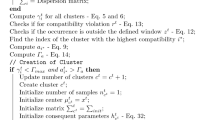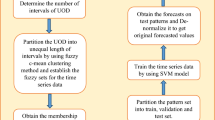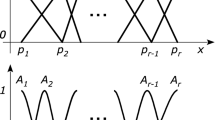Abstract
In this study, an efficient local online identification method based on the evolving Takagi–Sugeno least square support vector machine (eTS-LS-SVM) for nonlinear time series prediction is introduced. As an innovation, this paper has applied the nonlinear models, i.e. local LS-SVM models, as the consequence parts of the fuzzy rules, instead of the linear models used in the conventional evolving TS fuzzy models. In each step, the proposed learning approach includes two phases. The fuzzy rules (rule premise) are first created and updated adaptively based on a sequential clustering technique to obtain the structure of TS model. Then, the parameters of each local LS-SVM model (rule consequence) are recursively updated by deriving a new recursive algorithm (a local decremental and incremental procedure) to minimize the local modelling error and trace the process’s dynamics. Besides, a new learning algorithm based on the recursive gradient-based method is used to adaptively update the meta-parameters of the LS-SVM models. Comparison of the suggested method with some of the previous approaches based on the online prediction of the nonlinear time series has shown that the introduced identification algorithm has a proper performance in terms of learning and generalization abilities while having a lower redundancy.







Similar content being viewed by others
References
Abonyi J, Babuska R (2000) Local and global identification and interpretation of parameters in Takagi–Sugeno fuzzy models. In: Proceedings IEEE international conference on fuzzy systems, pp 835–840
An S, Liu W, Venkatesh S (2007) Fast cross-validation algorithms for least squares support vector machine and kernel ridge regression. Pattern Recognit 40(8):2154–2162
Angelov P, Filev D (2004) An approach to online identification of Takagi–Sugeno fuzzy models. IEEE Trans Syst Man Cybern B 34(1):484–498
Angelov PP, Filev D (2006) Simple_ eTS: a simplified method for learning evolving Takagi–Sugeno fuzzy models. In: Proceedings of the 11th IEEE international conference on fuzzy systems, pp 1068–1073
Angelov PP, Zhou X (2006) Evolving fuzzy systems from data streams in real-time. In: IEEE symposium on evolving fuzzy systems, Ambleside, Lake District, UK, pp 29–35
Angelov PP, Filev D, Kasabov NK (2008) Evolving fuzzy systems—preface to the special section. IEEE Trans Fuzzy Syst 16(6):1390–1392
Cheng WY, Juang CF (2011) An incremental support vector machine-trained TS-type fuzzy system for online classification problems. Fuzzy Sets Syst 163(1):24–44
Chi HM, Ersoy KO (2003) Recursive update algorithm for least squares support vector machines. Neural Process Lett 17:165–173
Diehl CP, Cauwenberghs G (2003) SVM incremental learning, adaptation and optimization. Proc Int Jt Conf Neural Netw Boston 4(1–4):2685–2690
Dovžan D, Škrjanc I (2011) Recursive clustering based on a Gustafson-Kessel algorithm. Evol Syst 2:15–24
Duda RO, Hart PE, Stork DG (2001) Pattern classification, 2nd edn. Wiley, New York
Engel Y, Mannor S, Meir R (2004) The kernel recursive least-squares algorithm. IEEE Trans Signal Process 52(8):2275–2285
Kalhor A, Araabi BN, Lucas C (2009) Online identification of a neuro-fuzzy model through indirect fuzzy clustering of data space. In: IEEE international conference on fuzzy systems, Korea
Kalhor A, Araabi BN, Lucas C (2010) An online predictor model as adaptive habitually linear and transiently nonlinear model. Evol Syst 1:29–41
Kasabov NK, Song Q (2002) DENFIS: dynamic evolving neural-fuzzy inference system and its application for time-series prediction. IEEE Trans Fuzzy Syst 10(2):144–154
Kim CH, Kim MS, Lee JJ (2007) Incremental hyperplane-based fuzzy clustering for system modeling. In: Proceedings of 33rd conference of IEEE industrial electronics society, Taipei, Taiwan
de Kruif B, de Vries T (2003) Pruning error minimization in least squares support vector machines. IEEE Trans Neural Netw 14(3):696–702
Leuven KU, Suykens JAK, Lukas L (2000) Sparse least squares support vector machine classifiers, Suykens JAK, Lukas L and Vandewalle J. In: Neural processing letters, pp 293–300
Li L, Yu H, Liu J, Zhang S (2010) Local weighted LS-SVM online modeling and the application in continuous processes. In: Wang F, Deng H, Gao Y, sheng Lei J (eds) Artificial intelligence and computational intelligence. Lecture notes in computer science, vol 6320. Springer, Berlin, pp 209–217
Li LJ, Su HY, Chu J (2007) Generalized predictive control with online least squares support vector machines. Acta Autom Sin 33(11):1182–1188
Lin CJ, Chen CH, Lin CT (2011) An efficient evolutionary algorithm for fuzzy inference systems. Evol Syst 2:83–99
Liu W, Park I, Wang Y, Príncipe JC (2009) Extended kernel recursive least squares algorithm. IEEE Trans Signal Process 57(10):3801–3814
Liu Y, Wang H, Li P (2007) Local least squares support vector regression with application to online modeling for batch processes. J Chem Ind Eng 58:2846–2851
Liu Y, Wang H, Yu J, Li P (2010) Selective recursive kernel learning for online identification of nonlinear systems with NARX form. J Process Control 20(2):181–194
Lughofer E (2008) FLEXFIS: a robust incremental learning approach for evolving Takagi–Sugeno fuzzy models. IEEE Trans Fuzzy Syst 16(6):139–1410
Lughofer E, Klement E (2005) FLEXFIS: a variant for incremental learning of Takagi–Sugeno fuzzy systems. In: Proceedings of FUZZ-IEEE, Reno, Nevada, USA, pp 915–920
Lughofer E, Bouchot JL, Shaker A (2011) On-line elimination of local redundancies in evolving fuzzy systems. Evol Syst. doi:10.1007/s12530-011-9032-3
Maia C, Goncalves M (2009) A methodology for short-term electric load forecasting based on specialized recursive digital filters. Comput Ind Eng 57(3):724–731
Martinez B, Herrera F, Fernandez J, Marichal E (2008) An incremental clustering method and its application in online fuzzy modeling. Stud Fuzziness Soft Comput 224:163–178
Mirmomeni M, Lucas C, Araabi B, Moshiri B, Bidar M (2011) Online multi-step ahead prediction of time-varying solar and geomagnetic activity indices via adaptive neurofuzzy modeling and recursive spectral analysis. Sol Phys 272:189–213
Ngia LS, Sjóberg J, Viberg M (1998) Adaptive neural nets filter using a recursive Levenberg-Marquardt search direction. In: Proceedings of the 32nd asilomar conference on signals, systems and computers, pp 697–701
Pandian SC, Duraiswamy K, Rajan CCA, Kanagaraj N (2006) Fuzzy approach for short term load forecasting. Electr Power Syst Res 76(6–7):541–548
Pouzols F, Lendasse A (2010) Evolving fuzzy optimally pruned extreme learning machine for regression problems. Evol Syst 1:43–58
Ramos JV, Pereira C, Dourado A (2010) The building of interpretable systems in real-time. In: Angelov PP, Filev D, Kasabov N (eds) Evolving intelligent systems: methodology and applications. Wiley, New York, pp 127–150
Smola AJ, Schölkopf B (2004) A tutorial on support vector regression. Stat Comput 14:199–222
Soleimani-B H, Lucas C, Araabi BN (2010) Recursive Gath-Geva clustering as a basis for evolving neuro-fuzzy modeling. Evol Syst 1:59–71
Suykens J, Brabanter JD, Lukas L, Vandewalleb J (2002) Weighted least squares support vector machines: robustness and sparse approximation. Neurocomputing 48(1–4):85–105
Suykens JAK, Vandewalle J (1999) Least squares support vector machine classifiers. Neural Process Lett 9:293–300
Tang HS, Xue ST, Chen R, Sato T (2006) Online weighted LS-SVM for hysteretic structural system identification. Eng Struct 28(12):1728–1735
Vapnik V (1995) The nature of statistical learning theory. Springer, New York
Yamauchi K (2010) Incremental model selection and ensemble prediction under virtual concept drifting environments. Evol Syst 6230:570–582
Yongping Zhao JS (2009) Recursive reduced least squares support vector regression. Pattern Recognit 42:837–842
Acknowledgments
The authors would like to express their gratitude to Mr. Mojtaba Kharrasi for help in proof reading and text edition.
Author information
Authors and Affiliations
Corresponding author
Appendix
Appendix
Proof
First consider \(Y_{K }^i = [ 0\quad {y_k^i(1)} \ldots{y_k^i({N - 1})}]^T \) where (N − 1) denotes the size of moving-windows for the ith local model after the pruning stage, y k+1 is new added output then we can derive (36) as following:
where e i k+1 is the prediction error computed by the difference between the desired signal and the output of the ith local model after the pruning stage (Dovžan and Škrjanc 2011).
Rights and permissions
About this article
Cite this article
Komijani, M., Lucas, C., Araabi, B.N. et al. Introducing evolving Takagi–Sugeno method based on local least squares support vector machine models. Evolving Systems 3, 81–93 (2012). https://doi.org/10.1007/s12530-011-9043-0
Received:
Accepted:
Published:
Issue Date:
DOI: https://doi.org/10.1007/s12530-011-9043-0




